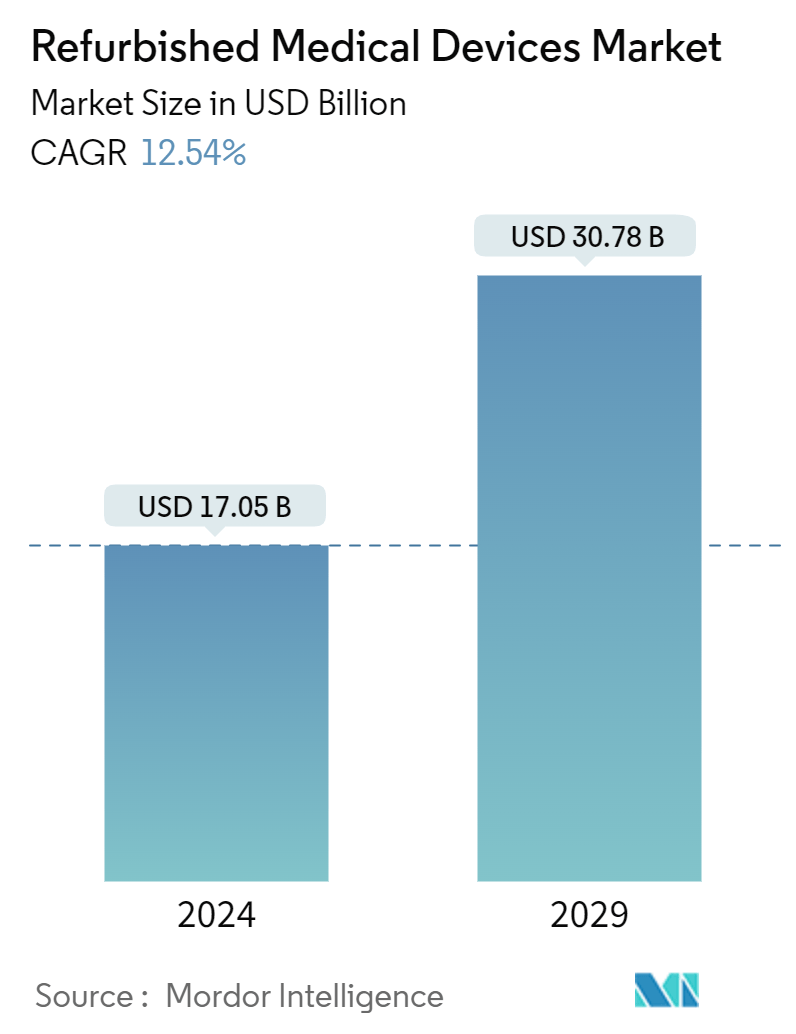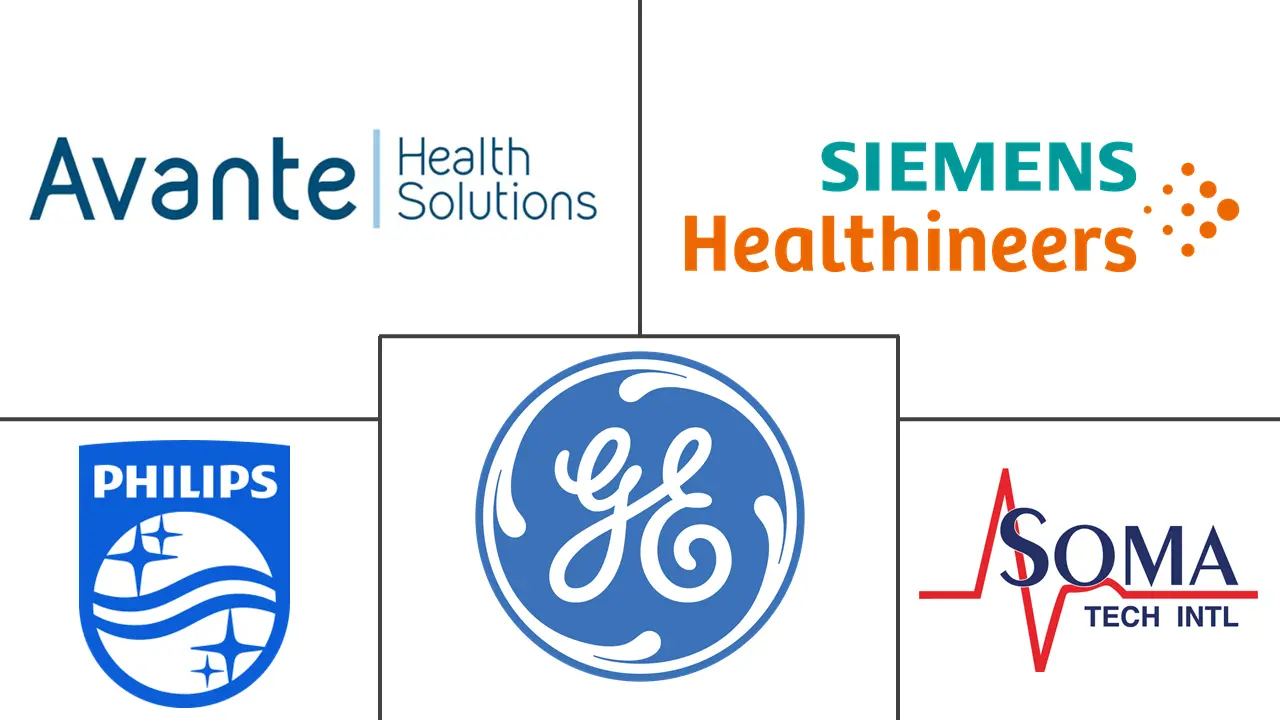Market Size of Refurbished Medical Devices Industry

| Study Period | 2019 - 2029 |
| Market Size (2024) | USD 17.05 Billion |
| Market Size (2029) | USD 30.78 Billion |
| CAGR (2024 - 2029) | 12.54 % |
| Fastest Growing Market | Asia Pacific |
| Largest Market | North America |
Major Players
*Disclaimer: Major Players sorted in no particular order |
Refurbished Medical Devices Market Analysis
The Refurbished Medical Devices Market size is estimated at USD 17.05 billion in 2024, and is expected to reach USD 30.78 billion by 2029, growing at a CAGR of 12.54% during the forecast period (2024-2029).
During the COVID-19 pandemic the demand for refurbished medical devices, like mechanical ventilators and patient monitoring devices increased significantly to cater to the need of a large patient base. However, supply chain disruption and trade ban had a negative impact on the refurbished medical devices market.
Factors such as cost containment pressure on healthcare organizations, availability of refurbished medical devices, and rise in healthcare service providers are expected to drive the market growth. For instance, according to the data published by the American Hospital Association in 2022, there are about 6,093 hospitals in the U.S. According to the same source, there are about 2,960, 1,228, 951, 207, 635, and 112 nongovernment not-for-profit community hospitals; investor-owned (for-profit) community hospitals; state and local government community hospitals; federal government hospitals; and nonfederal psychiatric hospitals, respectively. Also, according to Canada.ca, there were around 1,265 hospitals in Canada in 2022. Thus, the high number of healthcare facilities is expected to increase the demand for refurbished medical devices.
Along with the demand for new equipment, there is an increasing demand for refurbished medical equipment around the world. An increasing number of new hospitals are opting for alternate options to cut down on capital investments. Several hospitals prefer refurbished medical devices to save capital investment and offer healthcare services at affordable costs to patients. Moreover, the demand for refurbished medical devices is much higher in low- and middle-income countries, one of the primary reasons being underdeveloped health infrastructure and limited access to healthcare resources. Thus, factors such as affordability and the increasing number of healthcare service providers are anticipated to drive market growth over the forecast period.
However, quality issues of refurbished medical equipment among end users and reluctance to purchase refurbished medical equipment among healthcare providers are expected to hinder the market growth.
Refurbished Medical Devices Industry Segmentation
As per the scope, refurbishment is a methodical process that brings used equipment to almost the same condition as new equipment (or sometimes even better condition, in case upgrades, are available). Such action provides significant benefits both from an environmental and a social perspective. The Refurbished Medical Devices Market is Segmented by Product (Medical Imaging Equipment, Operating Room, and Surgical Equipment, Patient Monitors, Cardiovascular and Cardiology Equipment, Neurology Equipment, Endoscopy Equipment, Intensive Care Units, and Other Medical Equipment) and Geography (North America, Europe, Asia-Pacific, Middle East and Africa, and South America). The market report also covers the estimated market sizes and trends for 17 different countries across the major regions globally. The report offers the values (USD million) for the above segments.
| By Product | ||||||||
| ||||||||
| ||||||||
| ||||||||
| Cardiovascular and Cardiology Equipment | ||||||||
| Neurology Equipment | ||||||||
| Endoscopy Equipment | ||||||||
| Intensive Care Units | ||||||||
| Other Medical Equipment |
| Geography | ||||||||
| ||||||||
| ||||||||
| ||||||||
| ||||||||
|
Refurbished Medical Devices Market Size Summary
The refurbished medical devices market is poised for significant growth, driven by factors such as cost containment pressures on healthcare organizations and the increasing availability of refurbished equipment. The demand for these devices surged during the COVID-19 pandemic, particularly for essential equipment like mechanical ventilators and patient monitoring devices. However, challenges such as supply chain disruptions and trade bans have impacted the market. The high number of healthcare facilities, especially in regions like the United States and Canada, is expected to further boost demand. Hospitals are increasingly opting for refurbished devices to reduce capital investments and provide affordable healthcare services, particularly in low- and middle-income countries where healthcare infrastructure is underdeveloped.
The Asia-Pacific region is anticipated to experience the fastest growth in the refurbished medical devices market, fueled by the rising number of healthcare service providers and price sensitivity. The region's reliance on imported medical devices and the high cost of new equipment are driving the adoption of refurbished devices. Regulatory frameworks, such as those established by the Malaysian Medical Device Authority, are expected to enhance industry confidence and standardize processes, further propelling market growth. The market is highly competitive, with major players like GE Healthcare, Siemens Healthcare Systems, and Koninklijke Philips NV holding substantial shares. Recent strategic moves, such as acquisitions and partnerships, aim to expand capabilities and offer cost-effective solutions, particularly in the medical imaging segment.
Refurbished Medical Devices Market Size - Table of Contents
-
1. MARKET DYNAMICS
-
1.1 Market Overview
-
1.2 Market Drivers
-
1.2.1 Cost Containment Pressure on Healthcare Organizations
-
1.2.2 Large Inventory of Old or Used Medical Devices
-
1.2.3 Growing Rate of Private Healthcare Institutions
-
-
1.3 Market Restraints
-
1.3.1 Quality Issues of Refurbished Medical Equipment among End Users
-
1.3.2 Reluctance to Purchase Refurbished Medical Equipment Among Healthcare Providers
-
-
1.4 Porter's Five Forces Analysis
-
1.4.1 Threat of New Entrants
-
1.4.2 Bargaining Power of Buyers/Consumers
-
1.4.3 Bargaining Power of Suppliers
-
1.4.4 Threat of Substitute Products
-
1.4.5 Intensity of Competitive Rivalry
-
-
-
2. MARKET SEGMENTATION (Market Size by Value - USD million)
-
2.1 By Product
-
2.1.1 Medical Imaging Equipment
-
2.1.1.1 X-ray Machines
-
2.1.1.2 Ultrasound Systems
-
2.1.1.3 MRI Machines
-
2.1.1.4 CT Scanners
-
2.1.1.5 Nuclear Imaging Systems (Pet, Spect, and Pet/CT)
-
2.1.1.6 Other Medical Imaging Equipment
-
-
2.1.2 Operating Room and Surgical Equipment
-
2.1.2.1 Anesthesia Machines
-
2.1.2.2 CO2 and Agent Monitors
-
2.1.2.3 Microscopes
-
2.1.2.4 Electrosurgical Units
-
2.1.2.5 Other Operating Room and Surgical Equipment
-
-
2.1.3 Patient Monitors
-
2.1.3.1 Multiparameter Monitors
-
2.1.3.2 Electrocardiography Devices (ECG)
-
2.1.3.3 Non-invasive Blood Pressure Monitors
-
-
2.1.4 Cardiovascular and Cardiology Equipment
-
2.1.5 Neurology Equipment
-
2.1.6 Endoscopy Equipment
-
2.1.7 Intensive Care Units
-
2.1.8 Other Medical Equipment
-
-
2.2 Geography
-
2.2.1 North America
-
2.2.1.1 United States
-
2.2.1.2 Canada
-
2.2.1.3 Mexico
-
-
2.2.2 Europe
-
2.2.2.1 Germany
-
2.2.2.2 United Kingdom
-
2.2.2.3 France
-
2.2.2.4 Italy
-
2.2.2.5 Spain
-
2.2.2.6 Rest of Europe
-
-
2.2.3 Asia-Pacific
-
2.2.3.1 China
-
2.2.3.2 Japan
-
2.2.3.3 India
-
2.2.3.4 Australia
-
2.2.3.5 South Korea
-
2.2.3.6 Rest of Asia-Pacific
-
-
2.2.4 Middle East and Africa
-
2.2.4.1 GCC
-
2.2.4.2 South Africa
-
2.2.4.3 Rest of Middle East and Africa
-
-
2.2.5 South America
-
2.2.5.1 Brazil
-
2.2.5.2 Argentina
-
2.2.5.3 Rest of South America
-
-
-
Refurbished Medical Devices Market Size FAQs
How big is the Refurbished Medical Devices Market?
The Refurbished Medical Devices Market size is expected to reach USD 17.05 billion in 2024 and grow at a CAGR of 12.54% to reach USD 30.78 billion by 2029.
What is the current Refurbished Medical Devices Market size?
In 2024, the Refurbished Medical Devices Market size is expected to reach USD 17.05 billion.

